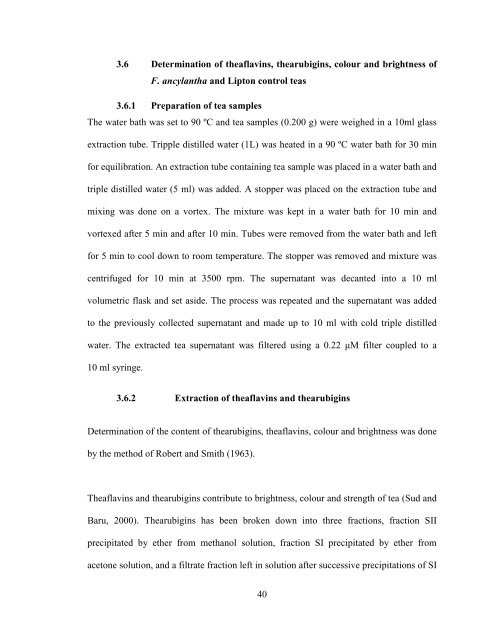a study of the quality of a local herbal tea and volatiles of parinari ...
a study of the quality of a local herbal tea and volatiles of parinari ...
a study of the quality of a local herbal tea and volatiles of parinari ...
You also want an ePaper? Increase the reach of your titles
YUMPU automatically turns print PDFs into web optimized ePapers that Google loves.
3.6 Determination <strong>of</strong> <strong>the</strong>aflavins, <strong>the</strong>arubigins, colour <strong>and</strong> brightness <strong>of</strong><br />
F. ancylantha <strong>and</strong> Lipton control <strong>tea</strong>s<br />
3.6.1 Preparation <strong>of</strong> <strong>tea</strong> samples<br />
The water bath was set to 90 ºC <strong>and</strong> <strong>tea</strong> samples (0.200 g) were weighed in a 10ml glass<br />
extraction tube. Tripple distilled water (1L) was heated in a 90 ºC water bath for 30 min<br />
for equilibration. An extraction tube containing <strong>tea</strong> sample was placed in a water bath <strong>and</strong><br />
triple distilled water (5 ml) was added. A stopper was placed on <strong>the</strong> extraction tube <strong>and</strong><br />
mixing was done on a vortex. The mixture was kept in a water bath for 10 min <strong>and</strong><br />
vortexed after 5 min <strong>and</strong> after 10 min. Tubes were removed from <strong>the</strong> water bath <strong>and</strong> left<br />
for 5 min to cool down to room temperature. The stopper was removed <strong>and</strong> mixture was<br />
centrifuged for 10 min at 3500 rpm. The supernatant was decanted into a 10 ml<br />
volumetric flask <strong>and</strong> set aside. The process was repeated <strong>and</strong> <strong>the</strong> supernatant was added<br />
to <strong>the</strong> previously collected supernatant <strong>and</strong> made up to 10 ml with cold triple distilled<br />
water. The extracted <strong>tea</strong> supernatant was filtered using a 0.22 µM filter coupled to a<br />
10 ml syringe.<br />
3.6.2 Extraction <strong>of</strong> <strong>the</strong>aflavins <strong>and</strong> <strong>the</strong>arubigins<br />
Determination <strong>of</strong> <strong>the</strong> content <strong>of</strong> <strong>the</strong>arubigins, <strong>the</strong>aflavins, colour <strong>and</strong> brightness was done<br />
by <strong>the</strong> method <strong>of</strong> Robert <strong>and</strong> Smith (1963).<br />
Theaflavins <strong>and</strong> <strong>the</strong>arubigins contribute to brightness, colour <strong>and</strong> strength <strong>of</strong> <strong>tea</strong> (Sud <strong>and</strong><br />
Baru, 2000). Thearubigins has been broken down into three fractions, fraction SII<br />
precipitated by e<strong>the</strong>r from methanol solution, fraction SI precipitated by e<strong>the</strong>r from<br />
acetone solution, <strong>and</strong> a filtrate fraction left in solution after successive precipitations <strong>of</strong> SI<br />
40


